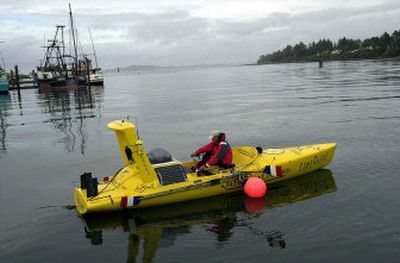Rower completes Pacific trip

CHARLESTON, Ore. – Emmanuel Coindre capsized 16 times in his attempt to row solo from Japan to the United States. Rain fell on his sleek yellow boat for 70 days. He broke a finger.
The 32-year-old Frenchman made landfall here on Tuesday after 129 days – towed behind a charter boat from what the owner said was a location 20 miles offshore.
Coindre became only the second person to be credited with successfully rowing across the Pacific from west to east – joining fellow Frenchman Gerard d’Aboville, whose starting point in 1991 was the same as Coindre’s: Choshi, Japan.
“I am very happy to succeed,” the sailing instructor told the Associated Press. “For the Atlantic you can speak about your record. For the Pacific you speak of a victory.”
Coindre has also made five solo Atlantic crossings.
Still, there will be an asterisk behind Coindre’s Pacific achievement because he didn’t row all the way to shore.
“We’ve been encouraging him for the past week to try to make landfall,” said Kenneth F. Crutchlow, executive director of The Ocean Rowing Society in London, England.
Crutchlow said that Coindre will go into his organization’s statistics as having completed the journey, with a notation that he was towed to shore.
Coindre had intended to row to San Francisco. But the current and waves were so strong that he missed his destination by about 400 miles, appearing off this town in southern Oregon.
The adventurer posted regular updates from his trip on his Web site.
On Sunday, he included this notation: “I am in a hurry to see my family and to walk on the firm ground to revive my legs.”
Coindre’s vessel is not your average rowboat.
A little more than 21 feet long and about 6 feet wide, it has a covered area for sleeping, for a galley and for communications equipment. The boat has an airfoil on the stern, watertight compartments and photovoltaic cells for power.
During the journey he ate protein bars, freeze-dried pasta and rice dishes cooked on a two-burner gas stove. For drinking water, he used a desalination system that had bacteria and membrane filters.
Slim and tan after more than three months at sea, Coindre said he prepared for the trip by running, riding a bicycle and working out on a rowing machine.
Wesley Trull, a Coast Guard spokesman in North Bend, said a charter boat from Coos Bay was sent to meet the rower on Tuesday.
“We have kind of been monitoring him for the last week,” Trull said. “He’s been a couple of hundred miles offshore for the last week. I’m not so sure his progress was moving the way it should, because of the currents. I don’t think he was having a good time.”
Trull said a whale-watching boat, the Miss Linda, ended up towing the rowboat to land.
Bob Pedro, owner of the Miss Linda, said Coindre spotted Pedro’s boat from about seven miles away and called the Miss Linda on his radio. Pedro said he picked Coindre up about 20 miles offshore.
“He was pretty glad to get onboard,” Pedro said. “It was a happy-sad occasion.”
Coindre’s mother and brother met him at the dock when the Miss Linda pulled in just after midnight.
Several hours later, Coindre had lunch with them.
His mother, Sylviane Coindre, said of his journey: “The Pacific Ocean is very dangerous. During his rowing I pray all the days.”